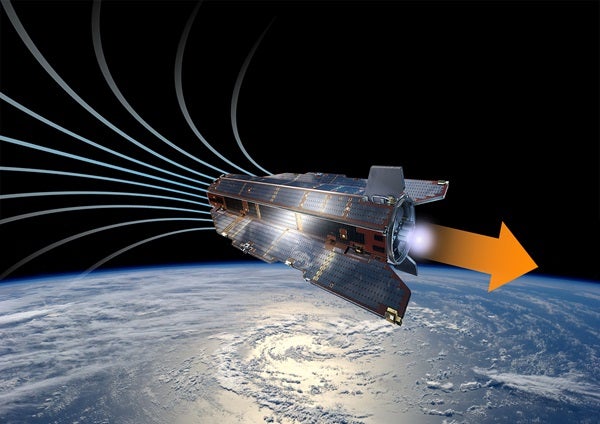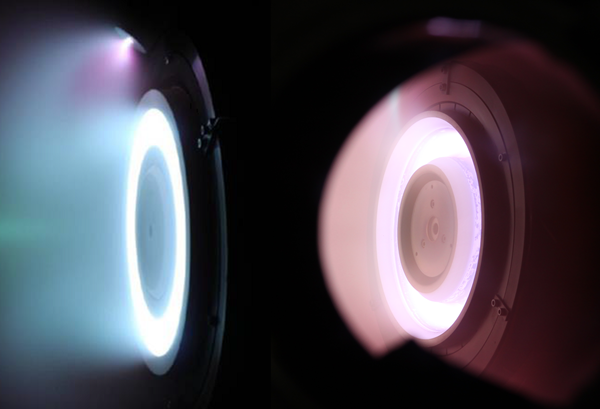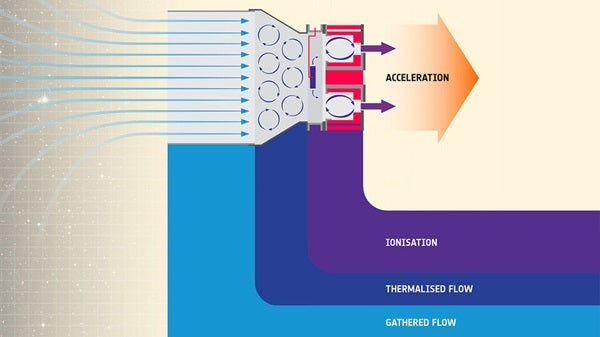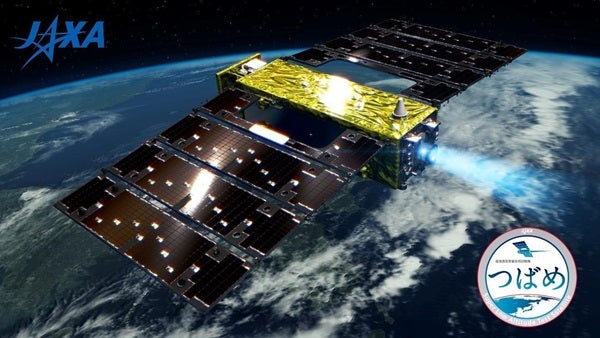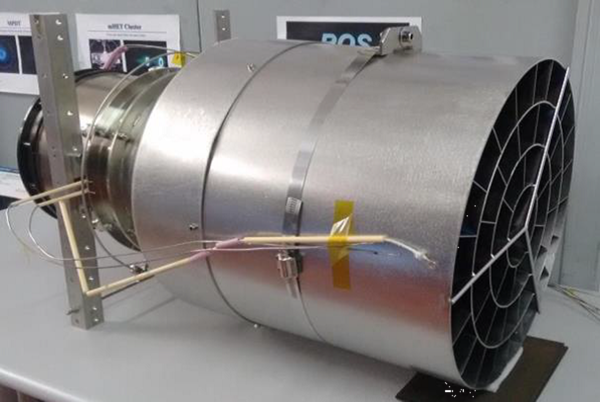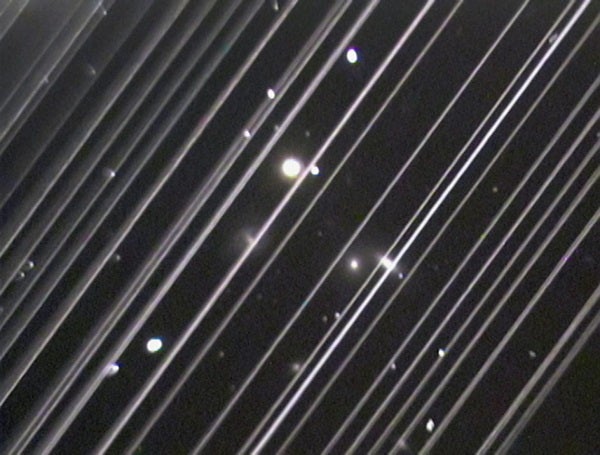When a satellite reaches orbit, it still has to contend with Earth’s atmosphere. Even 200 miles (320 kilometers) above the Earth’s surface, stray air molecules abound. They slow a satellite down, stealing its momentum, and dragging it inexorably downward, to its doom.
But a technology currently under study could turn those stray air molecules into a source of fuel to keep satellites aloft. The concept, called air-scooping electric propulsion (ASEP), has been discussed in space circles for decades, but is now getting renewed attention. And it could be a potential game-changer for satellite operators, argues a paper issued last month by researchers at The Aerospace Corporation, a nonprofit corporation based in El Segundo, California.
ASEP is something of a “holy grail” says co-author Rostislav Spektor, an electric propulsion researcher at Aerospace. A craft equipped with this technology could conduct extended operations at lower altitudes than any previous satellite. Lower orbits could benefit Earth observations, communications, and even help alleviate the issue of space junk.
But that could have one notable downside, say astronomers: If low-altitude orbits become viable, it would increase the number of satellites visible in the night sky to the naked eye.
Nevertheless, commercial operators may soon take more interest in the technology, says Spektor.
Into thin air
Air-scooping technology was first proposed in the 1960s as an offshoot of electric propulsion. While conventional rocket engines are powered by the chemical energy of a combustible fuel, electric propulsion uses electricity to accelerate and eject propellent — usually an inert, noncorrosive gas like xenon — out as exhaust.
Electric power is efficient: It can achieve far greater exhaust velocities than chemical rockets, although the ultimate amount of “oomph” is limited by how much electric energy the craft has onboard, which is typically generated from solar panels. Thus, electric propulsion is well suited to provide the gentle boosts needed to counteract the drag of air molecules, keeping spacecraft aloft.
That is, until the craft runs out of propellent to spit out the back.
That’s where air scoops come in. Instead of using a finite supply of xenon gas, an ASEP engine would use air molecules as propellant — and replenish its tank with a large scoop designed to collect them from its surroundings. From time to time, a craft in very low Earth orbit would turn on its solar-powered electric engine to stay aloft and avoid a fiery, meteoric death.
Because air-scooping satellites would never run out of propellent, they could operate indefinitely in very low Earth orbits (VLEO) at 120 miles (200 km) or lower, where drag would normally cause a spacecraft to fall to Earth within days.
“It’s the ultimate green technology,” says Spektor. “We use solar energy, we don’t take any chemicals with us on the satellite. You take air in, you throw air out — there is no chemistry in there.”
Low flyers
So far, no spacecraft has flown with an air scoop — but in 2017, the Japan Aerospace Exploration Agency (JAXA) launched a Super Low Altitude Test Satellite (SLATS), also named Tsubame, equipped with an electric engine and xenon propellant. It was able to maintain an orbit that dipped as low as 104 miles (167 km), setting a Guinness world record.
Orbiting so close to Earth has lots of benefits, says Karen Jones, a project manager and technology strategist at Aerospace’s Center for Space Policy and Strategy who co-authored the paper with Spektor. Among those benefits, Earth-observing satellites would be able to obtain higher-resolution images and data. And communications satellites would experience lower latency — crucial for activities like stock trading, navigation for self-driving cars, and online gaming.
In fact, satellites in VLEO are so close to the ground that they could provide cellular service to mobile phones directly, no special equipment needed. “VLEO could become very popular for those satellites willing to close those coverage gaps for our cellular providers,” says Jones.
There are potential military advantages as well. Low-flying satellites move across the sky faster, making them harder to track. And, as Colonel Eric Felt, director of the Air Force Research Laboratory Space Vehicles Directorate, told Forbes in 2020, “the resistance from the atmosphere makes it more difficult to predict where a given satellite is going to be at a certain point. We like that too.”
There’s also a sustainability argument: VLEO is self-clearing, as satellites can’t stay up without some form of propulsion. When JAXA decided to deorbit Tsubame in 2019, it simply turned the satellite off. Without further intervention, the craft burned up in the atmosphere within days. This approach could help alleviate the problem of space junk crowding up low-Earth orbit.
Farther afield
Air-breathing engines could also be useful in other ways. For instance, they could enable a new generation of space tugs — spacecraft that would tow satellites from low Earth orbit up to geosynchronous Earth orbit (GEO), where a satellite takes 24 hours to complete an orbit, remaining over the same part of Earth.
“It really has a possibility of changing the launch architecture,” says Spektor. Instead of “large, expensive rockets that get your satellites to geostationary orbit, you can have smaller rockets that launch your satellites to VLEO.” Then, an air-breathing space tug could boost it to its final orbit. After delivery, the tug would return to VLEO to refuel. “It’s ultimate reusability,” says Spektor.
With existing technology, it would take roughly one year for such a tug to fill its tanks with enough air for another GEO round trip, Spektor estimates. But that could be reduced with advancements in air scoop design.
ASEP technology could also be deployed on interplanetary missions to enable probes to get a closer look at worlds like Mars, sipping carbon dioxide from the outer fringes of its atmosphere.
Technical challenges
The air scoop itself is one of the largest remaining pieces of the technological puzzle. In 2018, a European Space Agency-funded group based in Italy and the Netherlands performed the first laboratory demonstration of an air scoop electric engine. Their scoop functioned as a passive compressor, using a gridded internal structure to take in air molecules and bounce them around, slowing them down so they could be captured and fed to the engine. The thruster then ionized the air molecules and used an electric field to accelerate them out the exhaust.
The key is efficiency — an air-scooping satellite must operate in a narrow window of the atmosphere where there are enough air molecules to collect for fuel, but not so many that they drag the craft down to its destruction. Alternative approaches could expand that window by using electric-powered compressors to achieve more thrust. More efficient solar panels would also improve performance.
Another challenge to VLEO and air-scooping satellites is durability. Since these craft would orbit lower in the atmosphere, they run a greater risk of degrading through oxidation — e.g., rusting — something that higher-altitude satellites operating in purer vacuum environments don’t need to worry about.
Still, these issues are surmountable, Spektor thinks. “I think there is nothing fundamentally that is there to stop us from doing this,” he says. “It all depends on how long it’s going to take us to overcome engineering challenges.”
Naked-eye objects
For all of the benefits of VLEO orbits, there is one issue that could raise the hackles of astronomers: their impact on the night sky.
Over the past two years, professional and amateur astronomers alike have expressed growing concern over the light pollution caused by SpaceX’s Starlink satellites. The company hopes to eventually form a 30,000-strong megaconstellation of spacecraft to provide global internet service.
Starlink satellites initially orbit at roughly 180 miles (291 km) and form bright trains in the night sky that disrupt both visual and research observations. Once the satellites ascend to their final orbits of roughly 340 miles (550 km), they are too dim to see with the naked eye but can still disrupt the activities of research telescopes. But VLEO could prove attractive to operators like SpaceX, says Jones.
The impact on astronomical research of much lower satellite constellations could be mixed. A satellite at 120 miles (200 km) is roughly two magnitudes brighter than one at 340 miles (550 km). But it is also visible for less time — by flying lower, it both moves faster and reflects sunlight for a shorter fraction of the night.
“The issues with a 200-km constellation are probably similar to those we face with Starlink,” says Jeffrey Hall, director of Lowell Observatory. “Satellites at any of these altitudes are blindingly bright for any research telescope — more than enough to saturate detectors,” he says.
But the impact on the night sky for amateurs and stargazers could be more severe. Starlink satellites in their final 550 km orbits “will be below naked-eye visibility, but a large constellation at 200 km probably would be visible, and this could seriously impact the visual appearance of the night sky,” says Hall. “The impacts and concerns there would extend well beyond astronomy.”
Growth triggers
ASEP technology is still in the research and development phase. But as the space market continues to develop, this technology could quickly find itself in the spotlight if the commercial incentives align, says Jones — for instance, if the space tug market takes off, or if concerns around orbital debris reach a fever pitch. “We think there’s going to be some interests that come into play to really advance this market,” says Jones.
And though some technical challenges remain, space technology can shift rapidly, notes Spektor. “I think we’re almost there, to be honest,” he says. “Whether it’s going to take two years or 10 years, it’s hard to say. You know, we’ve been trying to land rockets vertically for a long time, and suddenly — boom, we’re there.”

